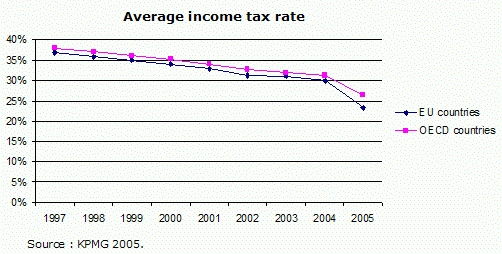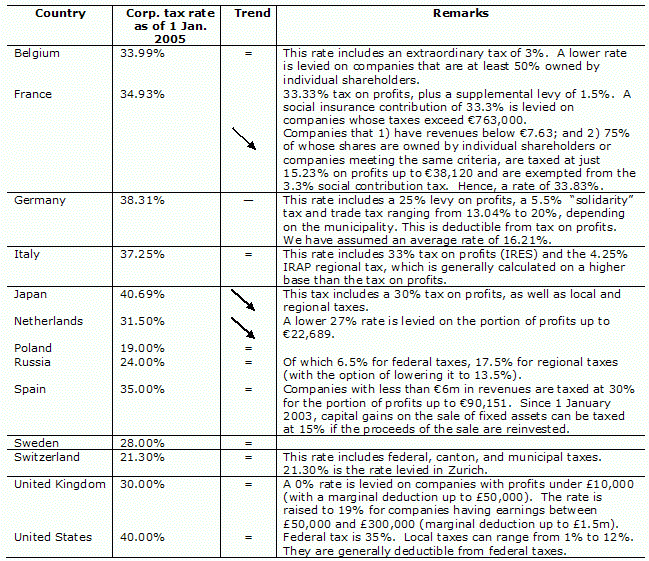Letter number 9 of Septembre 2005
- TOPIC
- STATISTICS
- RESEARCH
- QUESTIONS & COMMENTS
News : Should companies set a target rating?
This is obviously due mostly to the transition of continental Europe from an economy based mostly on banking intermediaries to one where the financial markets are becoming predominant.
CFOs can no longer shield themselves from this additional consideration. Ratings are even becoming one of their main concerns (1). Financial decisions are taken based partly on their rating impact; or, more precisely, decisions having a negative rating impact will be adjusted accordingly.
Some companies even set rating targets (Vivendi Universal, for example). This can seem paradoxical in two ways:
- Although all financial communication is based on creating shareholder value, companies are much less likely to set share price targets than rating targets;
- In setting rating targets, companies have a new objective: that of preserving value for bondholders! This is praiseworthy and, in a financial market context, understandable, but has never been part of the bargain with bondholders.
We see several possible explanations for this paradox:
- First of all, a debt rating downgrade is clearly a major event for a group and goes well behind bondholder information. A downgrade is traumatic and messy and almost always leads to a fall in the share price. So in seeking to preserve a financial rating, it is also shareholder value that management is protecting, at least in the short term.
- A downgrade can also have an immediate cost if the company has issued a bond with a step-up in the coupon, i.e. a clause stating that the coupon will be increased in the event of a rating downgrade. Step-ups are meant to protect lenders against a downgrade and obviously make managers pay more attention to their debt rating;
- A good debt rating guarantees some financial flexibility. The higher the rating, the easier it is to tap the bond markets, as transactions are less dependent on market fluctuations. An investment grade company, for example, can almost always issue bonds (2), whereas market windows close regularly for companies that are below investment grade. The seizing up of the high-yield market over the last few months is quite instructive here, as many issues have had to be postponed. The high-yield market is similar in this respect to the equities market. Under the new Basel II banking solvency standards the highest rated companies will probably have even greater flexibility, as loans to them will require lower reserve requirements and banks will more readily to them.
- Some banks sell the concept of lower cost of capital (and, thus, enhanced value) as a function of rating – for example, obtaining the lowest possible cost of capital for a BBB rating. This is based on the tax savings brought about by financing costs but, beginning with a certain level of debt, the savings are cancelled out by the discounted value of the cost of bankruptcy. Readers who know us well know that we are not great fans of this argument. For it looks difficult to maintain that companies rated BBB can be valued significantly higher than others. The average company rating is closer to A, after all, and major groups such as Nestlé and AstraZeneca, which have stable cash flows, do not try to play leverage, preferring to hold onto their very strong rating. Similarly, setting out to obtain the best rating possible is getting things backwards! This minimises the cost of debt, but so what? If it also requires an exorbitant level of equity, the cost of capital has not necessarily have been reduced.
There is a phenomenon that is even more perverse than setting a target rating: refusing to be rated or asking for a confidential “shadow rating”. Being rated can be scary, and CFOs balance out the lack of flexibility created by the lack of rating (e.g. certain investors can no longer be tapped and the bond market is mostly closed off) with the potential lack of flexibility created by a poor rating.
In extreme cases, we have even seen companies that, in their initial rating process, tried to obtain the worst possible rating for their particular financial profile. They have done this in order to gain some flexibility, i.e. some room for their situation to get marginally worse without undermining their rating. In this particular case, caution has a clear impact on value, as a lower rating means higher debt costs. But this is like an insurance premium that always looks too high until an accident strikes.
All in all, the desire of many companies to set a rating target reminds us that financial structure is above all the choice of the level of risk that shareholders choose to run and that the European debt market is becoming a real market with varied, segmented products, offered to investors who need some criteria in making their choices.
(2) On more or less good terms.
Statistics : Corporate income tax rates worldwide
In addition, Austria and the Netherlands significantly reduced their rates.
Research : Will Basel II induce a reduction in loans to small- and medium-sized companies?
The new Basel Accords, Basel II, will distinguish between small and large companies, in consideration of the fact that the lending bank does not bear as large a risk when lending to large companies as it does with small companies. Two researchers(1) attempt to analyse the foreseeable consequences of these amended rules for SMEs. Will SMEs be penalised by Basel II? Will they be at a disadvantage to large corporations when applying for loans?
Seeking answers to these questions, the two authors compare the amount of capital banks are required to hold when lending to large corporations with the amounts required when lending to SMEs of different sizes and in different economic sectors. They use the calculation method recommended by the Basel Committee, which factors in the default probability of the companies in question and the level of correlation between these default probabilities and general macro-economic conditions. The data was taken from Coface’s score@rating data base for 1996-2003. The authors obtained the following results:
As expected, larger companies have a lower default probability rate. However, there is a closer correlation between their default probability and macro-economic conditions than in the case of smaller companies. SMEs are more sensitive to risks that are specific to the individual company (e.g. the economic sector, the quality of management) than to the general economic risk. Lending banks are, nevertheless, able to reduce specific risk by creating a portfolio of diversified loans.
If we compare the current situation with the way things will stand once the new prudential rules are applied, SMEs should benefit from the reforms. The level of equity capital required for a loan to an SME will, in 93% of cases, be lower than the 8% required under the existing regulations. The average amount of the required solvency ratio has been brought down to 5.3%. Contrary to what may have been expected, banks will not have to reduce their loans to SMEs as a result of the new prudential rules
SMEs will however not obtain the same advantages as large corporations from the new rules for calculating required capital. Correlations between loans under Basel II are fixed at a higher level than those observed in practice. This penalises loans to SMEs, which naturally reduce the risk of a bank’s portfolio (given their small size) than loans to large groups. If we calculate the correlation between the default probability and the value of the portfolio of bank loans to SMEs, we get a figure of only 1.6%. According to the authors’ calculations, the calculation method under the new regulations puts this figure at 16%.
The results presented by the authors do not enable us to gain a full understanding of the overall impact of this reform on SMEs. Will banks in fact reduce the amounts they lend to SMEs in order to increase their loans to large corporations?
Given the fact that banks are really keen on lending, we can imagine that this is unlikely to be the case. In addition to the requirements in terms of equity capital, of which the banks today have plenty, the main thing to come out of this study is the highlighting of the low correlations among a portfolio of loans to SMEs, demonstrating why these sorts of assets are useful for diversifying bank portfolios.
Q&A : The financial structure used by Procter & Gamble to acquire Gillette
At the same time, Procter & Gamble announced its intention to spend $20bn buying up Procter & Gamble shares on the market over the next 12 to 18 months. This would make the acquisition a 60% paper / 40% cash deal.
Why did Procter & Gamble choose this structure rather than a 60% paper 41% cash takeover bid, which would have been a lot simpler? There are five reasons why this structure was chosen:
1. Once the merger has been approved by the two shareholders’ meetings, only a single entity remains, and not two as is the case after a takeover bid which may have to be followed by another bid and / or a squeeze out (1) in order to eliminate all of the target’s minority shareholders.
2. The negotiations and structuring of the debt needed to buy the shares take place after the deal is announced. Risks of leaks about the deal before the announcement are reduced, and the company probably has greater negotiating power over borrowing terms with banks.
3. The target’s shareholders may, for tax reasons, prefer to be paid in shares rather than in cash and this cannot be guaranteed in a cash-paper offer.
4. The cash does not only go to the shareholders of the target, but to all of the shareholders of the new group if they want it.
5. Buying up shares on the market always gives the impression that the company is supporting the share and is a relatively flexible process (amount, duration), with the only restriction the regulatory thresholds placed on issuers buying up shares.


